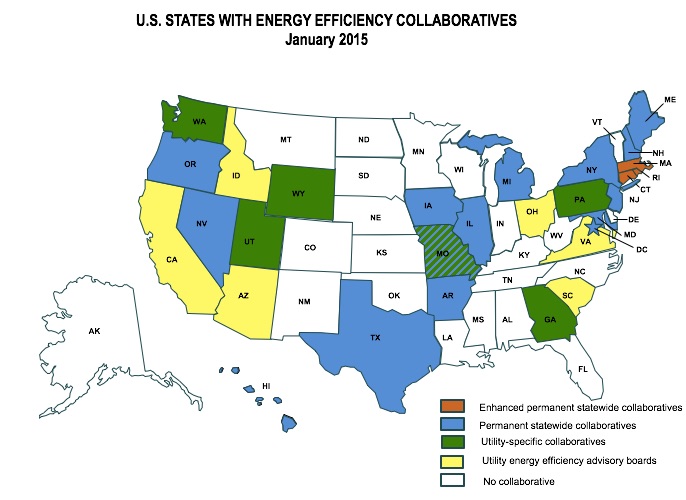Most energy proceedings are convened before a state public utility commission, and offer few opportunities for consumers and other stakeholders to participate. However, collaboratives provide an effective opportunity for multiple stakeholders to discuss a variety of issues in a constructive environment. Collaboratives are distinctly applicable to energy efficiency, which is unique among the energy resources in a utility’s portfolio. Collaboratives can be set up to address the full suite of issues associated with designing, implementing, and improving energy efficiency programs and adapting them to changing conditions.
Specifically, these collaboratives can help public utility commissions save program costs, improve decision quality, and add certainty to decision-making as commissions tweak existing, or put in place new, energy efficiency programs.
Collaboratives for energy efficiency have a long and successful history and currently exist in some form, in more than half of the U.S. states. Collaboratives gather stakeholder input on changing program budgets and program changes in response to performance or market shifts, as well as provide continuity while regulators come and go. They may also identify additional energy efficiency opportunities and innovations, assess the role of energy efficiency in new regulatory contexts, and draw on lessons learned and best practices from diverse constituencies. Collaboratives are often created to help work throughpolicy questions and, when possible, work out conflicts outside of the public utility commission setting.
A report by the State and Local Efficiency Action Network (with research support from RAP), Energy Efficiency Collaboratives, examines how energy efficiency collaboratives across the United States are created, their scope, how they make decisions, how their membership is identified, and what their relationships are with public utility commissions. The report identifies four types of collaboratives based on these attributes:
- Enhanced Collaborative: Characterized by a significant operating budget, statutory permanence, and a broad array of specific tasks and responsibilities;
- Permanent Statewide Collaborative: Created to address issues for all electric utilities (and possibly gas as well) in the state; is permanent as the result of statute, commission order, or track record; has a smaller budget relative to an enhanced collaborative; and could rely more on peer review and input to complete tasks rather than on dedicated staff;
- Utility-specific Collaborative: Established by the commission to foster stakeholder input for a single utility and otherwise operates in a similar manner to a permanent statewide collaborative; and
- Temporary Collaborative: Created to examine a defined set of issues; to be disbanded after completing its mission.
Only three states (Massachusetts, Rhode Island and Connecticut) have enhanced collaboratives; 15 other states have permanent statewide collaboratives, six states have utility specific collaboratives, and another six have energy efficiency utility advisory boards.

The report analyses the experience of existing collaboratives and distills the following overarching principles to be considered when developing a collaborative:
- Clear objective(s);
- “Rules of the road” for its work;
- Public, transparent, and inclusive processes;
- Periodic evaluation of progress;
- An experienced facilitator can be helpful; and
- Influence with the utility commission in order to be most useful.
“Increasingly, customers as a group are seen as a vital and strategic, demand-side power sector resource with distinct advantages over other resources,” the report explains. “States with energy efficiency collaboratives are likely to find themselves better able to respond to these trends and utilize this resource.”
As the electricity landscape across the U.S. changes, cooperative efforts that include a range of stakeholders—like energy efficiency collaboratives—will mature as a necessary and helpful resource. Energy Efficiency Collaboratives can help state policymakers build, expand, and manage these collaboratives so these groups can play their role effectively and help smooth the path toward a transformed power sector.
